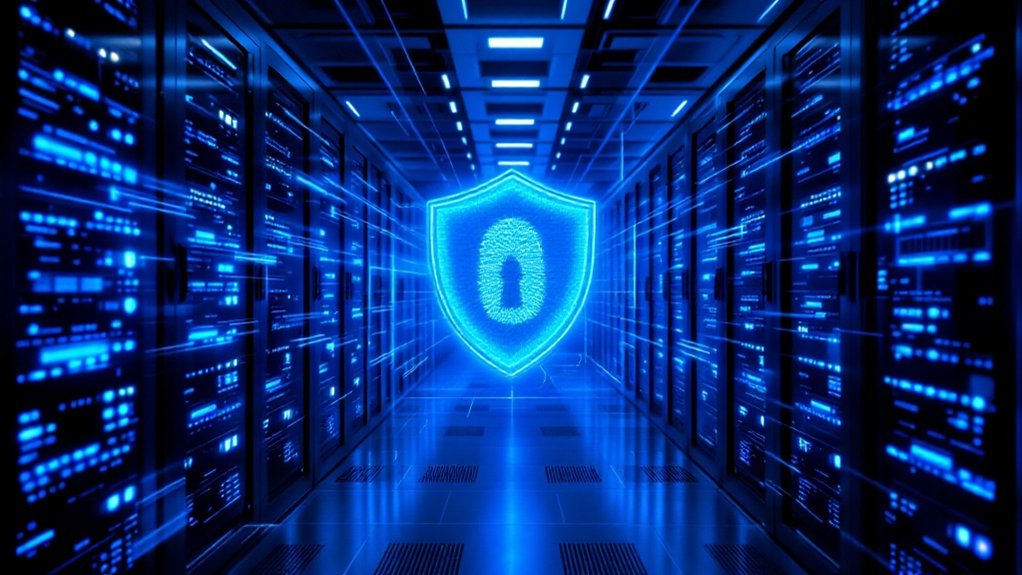As we approach 2023, the rapidly evolving landscape of cyber threats continues to challenge data center security. The need for robust protection strategies has never been more critical. This article will explore the latest best practices, from the adoption of a zero-trust model and advanced encryption methods to the utilization of AI for intelligent threat detection. Stay tuned as we unravel how these strategies can enhance your organization’s resilience against sophisticated cyber-attacks.
Understanding the Current Cyber Threat Landscape
In today’s digital era, comprehending the current cyber threat landscape proves essential in fortifying data center security. As the digital space expands, so does the array of threats. Cyber-attacks are now more sophisticated, targeting data centers with ransomware, DDoS attacks, and advanced persistent threats (APTs). Hackers employ AI and machine learning to bypass defenses, making traditional security measures inadequate. Insider threats, either from disgruntled employees or unwitting accomplices, are also on the rise. Understanding these threats helps businesses devise robust security strategies. This includes regular vulnerability assessments, adopting a zero-trust security model, and implementing multi-factor authentication. Furthermore, data centers must recognize the importance of data management services to effectively mitigate risks and enhance overall security. Without this knowledge, data centers risk not only financial loss but also reputational damage that could take years to repair.
The Role of Encryption in Data Center Security
While understanding the wide range of threats is essential, deploying effective security measures such as encryption is equally important for safeguarding data centers. Encryption, the practice of converting data into a code to prevent unauthorized access, plays a vital role in data center security. It acts as the first line of defense, protecting sensitive information even if a breach occurs. There are various types of encryption techniques, but all serve the same purpose: to transform readable data into unreadable code. In 2023, utilizing advanced encryption standards is significant to maintain the integrity and confidentiality of data. Furthermore, encryption not only protects data within the center but also safeguards data in transit between data centers or to end users. It is a key component in a multi-layered security strategy. Additionally, participating in data center webinars can provide valuable insights on the latest encryption standards and practices.
Implementing Advanced Intrusion Detection Systems
In the landscape of data center security, the implementation of advanced intrusion detection systems holds paramount importance. A key aspect of these systems is intelligent threat recognition, a mechanism designed to identify potential security risks. Alongside this, establishing robust intrusion response protocols is essential, as it determines how effectively a data center can respond to detected threats. Furthermore, ensuring that data centers have impenetrably secure server rooms is vital for maintaining the integrity of client databases.
Intelligent Threat Recognition
Recognizing threats intelligently through the implementation of advanced intrusion detection systems is a crucial aspect of data center security. As cyber threats evolve, so too should defensive strategies. The intelligent threat recognition approach uses machine learning and AI to detect unusual patterns and potential threats, a considerable step up from traditional rule-based systems. This method helps in identifying zero-day attacks, which are often missed by conventional systems. It includes analyzing network traffic, spotting anomalies, and interpreting unusual behavior as potential threats. In 2023, the focus will be on integrating these systems with predictive analytics to anticipate threats before they occur. This proactive approach can greatly reduce the risk of data breaches, ensuring ideal data center security.
Intrusion Response Protocols
Building upon the intelligent recognition of threats, data centers must also establish robust intrusion response protocols. These protocols include the implementation of advanced intrusion detection systems (IDS) that identify malicious activity, anomalies, and policy violations. A thorough IDS can alert IT professionals to any potential breach, allowing for immediate action.
However, the efficacy of these systems lies not just in their ability to detect, but also in the speed and efficiency of their response. Rapid containment and neutralization of threats can greatly limit the extent of damage. Additionally, a post-incident analysis should be carried out to understand the intrusion and improve future responses. By doing so, data centers can enhance their defenses and resilience against increasingly sophisticated cyber threats.
The Significance of Regular Security Audits
Regular security audits hold a pivotal role in maintaining the integrity of data center operations. This discussion will explore the importance of these audits, strategies for conducting them effectively, and necessary actions to take after an audit. Understanding these aspects guarantees the robustness of security protocols and the preservation of data confidentiality and accessibility. Additionally, incorporating real-time monitoring into security audits can enhance the detection of potential vulnerabilities and improve overall security posture.
Importance of Security Audits
Why are security audits essential for data centers? They serve as a vital tool in the identification and mitigation of potential risks, ensuring that a data center’s security measures are robust and up-to-date. Regular security audits provide a thorough overview of the center’s current security status, pinpointing vulnerabilities before they become significant threats. They also offer an opportunity to review and refresh the center’s security policies and procedures, thereby ensuring they remain aligned with best practices and regulatory requirements. Additionally, these audits demonstrate a commitment to data security to stakeholders, enhancing trust and credibility. Importantly, the significance of security audits goes beyond mere compliance – they are a critical aspect of maintaining a proactive, resilient security posture in data centers.
Conducting Effective Audits
How can data centers guarantee they are conducting effective security audits? This is achieved by establishing a systematic approach that highlights potential vulnerabilities. Initially, audits involve extensive risk assessments, scrutinizing every aspect of the data center’s infrastructure, processes, and personnel. Regularly scheduled audits are essential, as they help detect new threats that may emerge over time. However, the effectiveness of audits is determined by the quality of their execution. They should be thorough, unbiased, and carried out by competent auditors. Utilizing modern automated tools can enhance audit accuracy and efficiency. In addition, audits should align with the latest cybersecurity standards and regulations. However, the significance of an audit lies not in its execution but in the actionable insights it produces, which will be discussed in the following section.
Post-Audit Follow-Up Actions
What is the next step after a thorough security audit? Post-audit follow-up actions are essential. These actions guarantee that the vulnerabilities identified during the audit are addressed promptly and effectively. A data center must enact remediation strategies to correct each security weakness. This can range from patching software, updating system configurations, to implementing new security measures. In addition, a re-evaluation should be scheduled to verify the efficacy of these actions. Regular security audits are not just about finding flaws; they are also about confirming that these flaws are fixed. For data centers, the end goal is not merely to pass an audit but to maintain a consistently high level of security. Hence, post-audit follow-up actions are a significant part of data center security best practices.
Utilizing Artificial Intelligence for Threat Detection
While many traditional security measures remain essential, the incorporation of Artificial Intelligence (AI) for threat detection has increasingly become a cornerstone in data center security strategies. AI, with its machine learning capabilities, can recognize patterns and detect anomalies in vast amounts of data more accurately and rapidly than any human could. These characteristics make AI invaluable in identifying potential threats before they can cause significant damage. It can also adapt to evolving threats, learning from every interaction, thereby constantly improving its detection efficiency. However, the implementation of AI should be carefully managed, considering the potential for false positives. Consequently, combining AI with human oversight is often the most effective approach to threat detection in data centers. Additionally, AI’s ability to provide data-driven insights enables organizations to make informed decisions regarding their security posture.
The Importance of Data Backup and Recovery Strategies
Certainly, a robust data backup and recovery strategy plays a significant role in data center security. Data is an irreplaceable asset; loss or corruption can cause considerable harm to an organization’s operations and reputation. Consequently, having a thorough plan that guarantees the preservation and restoration of data is essential. This includes regular backups, both on-site for quick recovery and off-site for disaster recovery. Additionally, such strategy should be automated and tested frequently to confirm its effectiveness. The goal is not only to protect data from common risks like system failures and human errors but also from emerging threats such as ransomware attacks. Fundamentally, a solid data backup and recovery strategy is a crucial element of a secure data center.
Building a Strong Security Culture Within the Organization
Despite the importance of technical measures in securing a data center, cultivating a strong security culture within the organization is equally critical. It goes beyond rules and regulations, fostering an environment where every employee understands their role in safeguarding the company’s data. This culture starts with education and awareness, ensuring all staff are well-versed in potential threats and the steps to prevent them. Regular training sessions can reinforce these lessons, keeping security front-of-mind. In addition, organizations should promote open communication about security incidents, ensuring everyone can learn from any breaches. By instilling a strong security culture, companies can develop a powerful defense that complements their technical security measures, making their data centers more robust against threats.
Adopting Multi-Factor Authentication for Enhanced Security
To bolster data center security, adopting multi-factor authentication is a highly effective strategy. It works by requiring users to provide two or more separate forms of identification before gaining access to sensitive data. This approach notably mitigates the risk of unauthorized access, as it is unlikely for an attacker to possess all the necessary credentials. Typically, multi-factor authentication combines something the user knows, like a password; something the user has, such as a mobile device; and something the user is, for instance, a biometric feature. The adoption of this security measure in data centers for 2023 is essential, considering the increasingly sophisticated nature of cyber threats. It forms a robust security layer that makes data breaches considerably more challenging for potential intruders.
Future Trends in Data Center Security for 2023 and Beyond
Looking ahead, the landscape of data center security is set to evolve with emerging technologies and the ever-growing complexity of cyber threats. A key trend for 2023 and beyond is the integration of artificial intelligence (AI) and machine learning (ML) in security systems. These technologies can identify, predict, and respond to threats more rapidly and accurately. Cybersecurity mesh, another emerging trend, allows for flexible, scalable, and reliable security perimeters. As data centers become more distributed, security will also shift from a centralized model to a more decentralized one. The proliferation of quantum computing, while still in its infancy, poses new challenges but also offers innovative solutions. These trends, among others, are shaping the future of data center security.
Frequently Asked Questions
What Are the Costs Associated With Implementing a Data Center Security System?
The costs of implementing a data center security system vary considerably. They depend on factors such as system complexity, required hardware and software, labor, maintenance, potential downtime, and the need for ongoing security updates and monitoring.
How Can Data Center Security Practices Impact Business Continuity Planning?
Effective data center security practices are pivotal in business continuity planning. They mitigate risks of data breaches and downtime, ensuring uninterrupted business operations, thereby enhancing reliability and building trust with stakeholders and clients.
What Certifications Should a Data Center Security Professional Hold?
A data center security professional should ideally hold certifications such as Certified Information Systems Security Professional (CISSP), Certified Information Security Manager (CISM), and Certified Ethical Hacker (CEH) to guarantee thorough knowledge and skillset.
How Does Physical Security Integrate Into Data Center Security Strategy?
Physical security integration in data center strategy involves restricting unauthorized access and protecting the infrastructure from physical threats. It includes measures such as surveillance systems, secure access protocols, and disaster prevention mechanisms.
What Is the Role of a Data Center Security Officer in an Organization?
The data center security officer’s role in an organization involves ensuring the safety of the data center’s physical and digital assets, implementing security protocols, and coordinating with IT teams to mitigate potential security risks.
Conclusion
As cyber threats continue to evolve, data centers in 2023 must employ robust security measures. A multi-layered approach, combining regular audits, advanced encryption, AI-based threat detection, and multi-factor authentication, is key. Also essential is fostering a security-conscious culture within the organization and ensuring robust data backup systems. By understanding the current threat landscape and staying abreast of emerging trends, data centers can protect their critical assets and maintain their integrity and availability.






